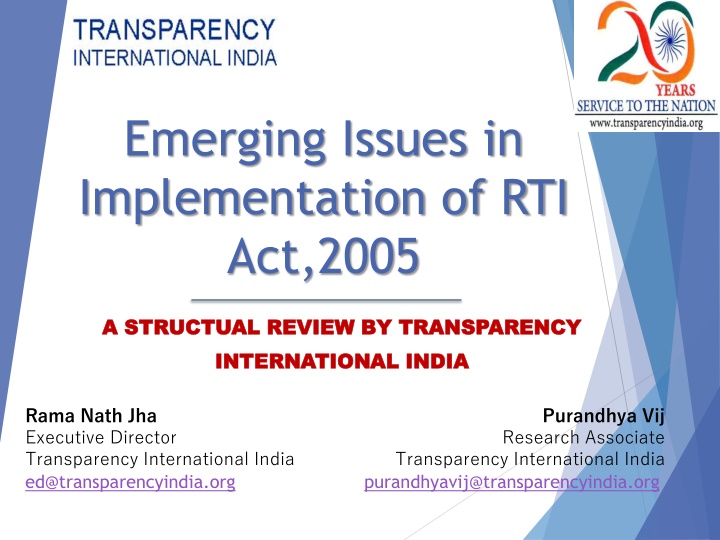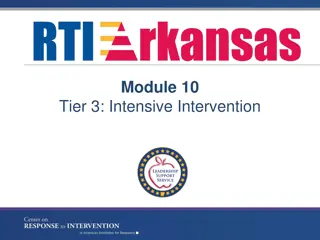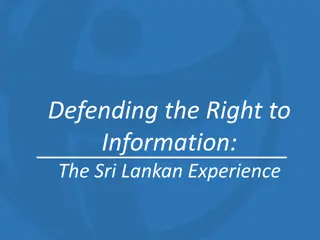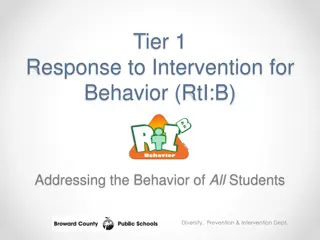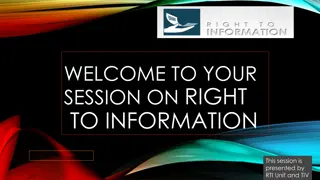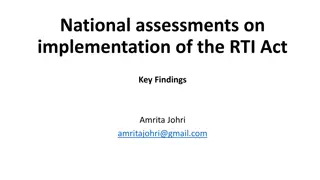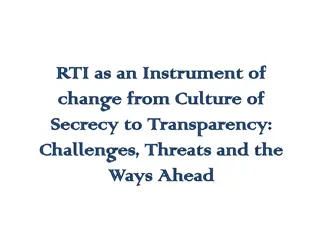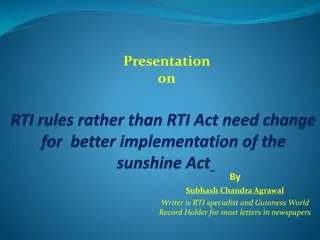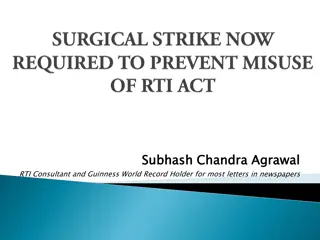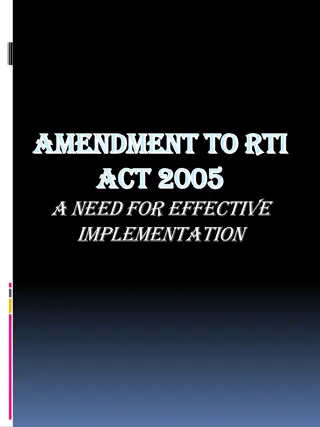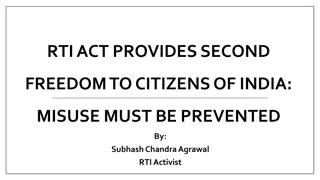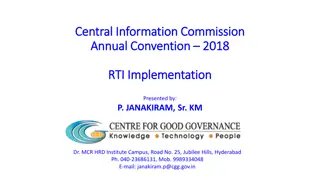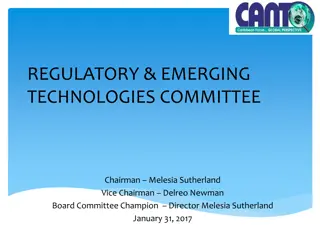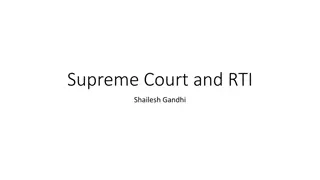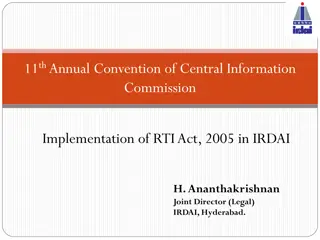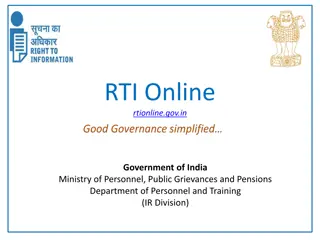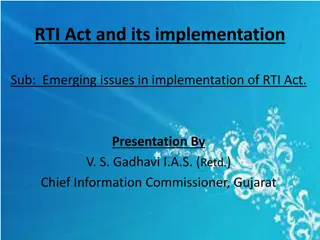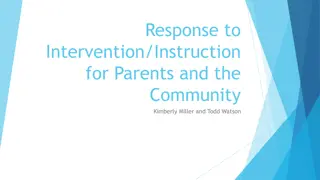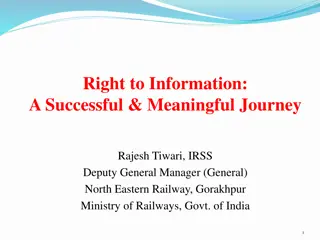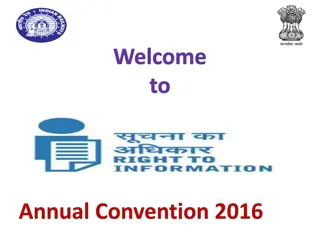Emerging Issues in Implementation of RTI Act, 2005: Structural Review
This research delves into the structural review of the implementation of the RTI Act, 2005 in India, shedding light on the functioning at the state level. It analyzes key aspects such as the number of RTI applications received, second appeals and complaints, penalties imposed on public authorities, and challenges faced by stakeholders. Insights from actual experiences in 28 states are examined to strengthen the RTI Act, with a focus on enhancing transparency and accountability.
Download Presentation

Please find below an Image/Link to download the presentation.
The content on the website is provided AS IS for your information and personal use only. It may not be sold, licensed, or shared on other websites without obtaining consent from the author.If you encounter any issues during the download, it is possible that the publisher has removed the file from their server.
You are allowed to download the files provided on this website for personal or commercial use, subject to the condition that they are used lawfully. All files are the property of their respective owners.
The content on the website is provided AS IS for your information and personal use only. It may not be sold, licensed, or shared on other websites without obtaining consent from the author.
E N D
Presentation Transcript
Emerging Issues in Implementation of RTI Act,2005 A STRUCTUAL REVIEW BY TRANSPARENCY A STRUCTUAL REVIEW BY TRANSPARENCY INTERNATIONAL INDIA INTERNATIONAL INDIA Rama Nath Jha Executive Director Transparency International India ed@transparencyindia.org Purandhya Vij Research Associate Transparency International India purandhyavij@transparencyindia.org
About the research The litmus test for the successful implementation of RTI Act, is its functioning at the state level. This research anchored in actual experience will help in identifying the strengths and weaknesses in each of the 28 states (excluding Telangana, though SIC has been constituted but is yet to start functioning) and act as an eye opener in strengthening of the RTI Act. Central Information Commission, setting an example, has also been analyzed, bringing out the best practices for the respective state commissions to follow. Scope of study : Number of RTI Applications Received Number of Second Appeals & Complaints Received Cases of Penalties Imposed on Public Authorities/Disciplinary Action Status of Vacancy in Union/State Information commissions Challenges faced by different stakeholders ( Source: Annual Report/Information Sent by State Information Commission : Year 2005 -2016)
Total RTI Applications received Source: Annual Report/Information Sent by State Information Commission
Average RTI/ Per Year (A/B =C) Number of RTI as Recorded from the year 2005 to 2016 (As case may be) 5743471 699258 18728 127788 864222 602728 32283 1036505 182621 424252 73452 21327 2278082 2192571 184112 5495788 2267 13308 10308 16026 285961 594709 855677 3794 1923388 21305 0 613718 77302 24394951 No. of years for which data is available Governments Central Govt. Andhra Pradesh Arunachal Pradesh Assam Bihar Chhattisgarh Goa Gujarat Haryana Himachal Pradesh Jammu & Kashmir Jharkhand Karnataka Kerala Madhya Pradesh Maharashtra Manipur Meghalaya Mizoram Nagaland Odisha Punjab Rajasthan Sikkim Tamil Nadu Tripura Uttar Pradesh Uttarakhand West Bengal Total 87407.25 2080.88 11617.09 96024.67 522133.70 54739.45 6456.60 94227.72 26088.71 38568.37 14690.40 3046.71 227808.20 199324.64 16737.45 549578.80 251.88 1209.81 1030.80 1780.66 31773.44 66078.78 85567.70 1264.66 213709.70 2367.22 11 8 9 11 9 11 5 11 7 11 5 7 10 11 11 10 9 11 10 9 9 9 10 3 9 9 0 11 11 0 55792.54 663.80 Source: Annual Report/Information Sent by State Information Commission
Second Appeals and Complaints TOP 5 RECEPIENTS Maharashtra Central Information Commission Bihar Karnataka Gujarat Source: Annual Report/Information Sent by State Information Commission
Vacancy (As on December 2, 2017) S.NO Information Commissions Chief Information Commissioner Information Commissioner Sanctioned strength Vacancy Sanctioned strength Vacancy 10 1 Central Information Commission 1 0 3 2 3 4 5 6 7 8 9 10 11 12 13 14 15 16 17 18 19 20 21 22 23 24 25 26 27 28 29 30 Andhra Pradesh Arunachal Pradesh Assam Bihar Chhattisgarh Goa Gujarat Haryana Himachal Pradesh Jammu & Kashmir Jharkhand Karnataka Kerala Madhya Pradesh Maharashtra Manipur Meghalaya Mizoram Nagaland Odisha Punjab Rajasthan Sikkim Tamil Nadu Telangana Tripura Uttar Pradesh Uttarakhand West Bengal 1 1 1 1 1 1 1 1 1 1 1 1 1 1 1 1 1 1 1 1 1 1 1 1 1 1 1 1 1 0 0 0 0 1 0 0 0 0 0 0 0 0 0 0 0 0 0 0 0 0 0 0 0 0 0 0 0 0 10 4 2 4 3 10 3 10 2 2 7 (not more than 10) 5 Not more than 10 Not more than 10 Not more than10 0 1 1 2 9 2 0 5 1 2 10 5 10 2 1 0 1 1 8 0 1 1 1 5 5 5 6 4 0 0 1 0 0 1 0 0 0 0 2 2 3 8 The sanctioned strength of Chief Information Commissioner(Union & State) is 30, out of which 1 are vacant The sanctioned strength of Information Commissioners(Union & State) is 160, out of which 61 are vacant Source: Annual Report/Information Sent by State Information Commission
Penalty and Compensation S.NO. STATES NO. OF CASES 537 1329 465 54 463 982 335 327 2295 202 21 328 1307 - 255 1404 10 46 3 49 833 202 2803 21 - - 5 - 788 157 PENALTY COMPENSATION - - 162000 - - - - - 6397837 828742 - - - - - - 46000 - - - - 1191480 789400 - - - - - - - Central Information Commission Andhra Pradesh Arunachal Pradesh Assam Bihar Chhattisgarh Goa Gujarat Haryana Himachal Pradesh Jammu & Kashmir Jharkhand Karnataka Kerala Madhya Pradesh Maharashtra Manipur Meghalaya Mizoram Nagaland Odisha Punjab Rajasthan Sikkim Tamil Nadu Telangana Tripura Uttar Pradesh Uttarakhand West Bengal 19176325 15038252 1918650 1145500 2712750 4926200 1 2 3 4 5 6 7 8 9 - 3625000 22853489 2331950 300900 1085000* 47204608 2743250 3633250 14319373 137750 415475 68000 657250 11000259 3770870 34947250 * - - - 57500 - 8103842 187750 10 11 12 13 14 15 16 17 18 19 20 21 22 23 24 25 26 27 28 29 Source: Annual Report/Informati on Sent by State Information Commission
Challenges faced by different stakeholders Information Seeker o Low awareness level, particularly among marginalized section. o Unsupportive attitudes of PIOs are leading to unsatisfactory and poor quality replies by PIOs. o Ritualistic approach by First Appellate Authority, huge pendency and leniency towards PIOs at Information Commission level.
Cont... Public Information Officer (PIO) o Ineffective record management system particularly in state field offices/ departments including poor digitalization o Inadequate training to PIO & FAAs particularly on key order/judgments of Information commissions and courts o Limited use of IT like in Case Management System and 'e reply' during processing RTI applications.
Cont State Information Commission o Absence of Infrastructure and Inadequate human resources in Commission. o High Level of Pendency and vacancy in Information Commission. o Absence of culture of Suo Moto disclosure of information.
Recommendations TECHNOLOGY: use of innovative technology to disclose more information through the government websites across all platforms including vast mobile connectivity and mobile applications, in multiple languages will in itself make the system transparent TRAINING: A dedicated center to give training to the PIOs and civil society will go a long way and will equip them with desired skills. SUO MOTO DISCLOSURES: Section 4(1)(b) of the RTI Act, 2005 makes it mandatory for the respective commissions to disclose information. AWARENESS: Lack of awareness among the stakeholders of the RTI Act, will prove detrimental to the objective of having a wide reach. THANK YOU !!!
